hey friend!
I'm Martina.
I provide practical, time-saving strategies that actually work—so you can engage your students, teach effectively, and reclaim your time from the exhausting planning-grading cycle.
Browse Our ELA Resources
Guided Reading and Small Groups in Middle School PART I
Why Guided Reading in Middle School Matters
If you’ve ever wondered whether guided reading belongs in middle school ELA, this post is for you.
When I first moved from elementary to 6th grade, I was drowning. I was used to having plenty of time for reading blocks, but suddenly, I had 55 minutes to cover everything—reading, writing, grammar, spelling, and vocabulary.
Meeting all of my students’ needs felt impossible. Classroom management was shaky. And I honestly questioned whether small groups even made sense in middle school.
But here’s the truth: guided reading and small groups absolutely belong in middle school—and once I figured out how to make them work, everything changed.
This post is the first in a three-part series where I share exactly how I implemented guided reading and small groups in my middle school classroom:
- One: Guided Reading and Small Group
- Two: Student Routines, Daily 5, and More
- Three: Small Group Alongside Curriculum and Whole Group
📥 Want a head start? Click here to get my Middle School Guided Reading Recording Sheets sent straight to your inbox. You’ll also get access to my free small group toolkit and exclusive teaching ideas.
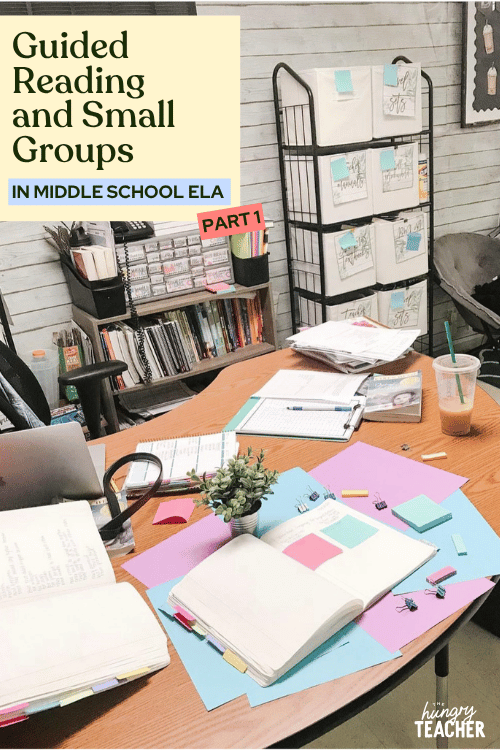
How I Structured My Middle School ELA Block
Here’s what my daily ELA block looked like (I had two 6th-grade classes and used this schedule for both):
My 6th Grade ELA Schedule:
10 minutes: ELA Bell Ringer
30 minutes: Collections (core ELA curriculum)
20 minutes: Round 1 — Guided Reading + Daily 5
25 minutes: Novel Lesson – Read Aloud (10), Socratic Seminar (7), Reading Response (8)
20 minutes: Round 2 — Guided Reading + Daily 5
It took a lot of trial and error to find what worked, but once I started using this consistent rotation, my classroom ran smoothly, and I was finally able to meet with all of my students regularly.
👉 [Grab my editable guided reading schedule template here – as part of the small groups toolkit!]
After we do our ELA Bell Ringer and our Collections lesson, I do my first round of groups. It took A LOT of trial-and-error, A LOT of re-organization, and A LOT of flexibility on my part. After playing around with some stuff, this was the schedule I came up with. I had two 6th-grade ELA classes.
Above, I mentioned “Round 1” and “Round 2” when my students were doing Daily 5 and small group. This is a breakdown of what those groups looked like:

HOW OFTEN I MEET WITH GROUPS
INTENSIVE GROUPS
I wanted to meet with my intensive groups at least two times a week. That being said, I typically get to meet with them three times a week because of our intervention block. This can change if I need to do assessments or work with other students at this time.
PROFICIENT GROUPS
My proficient group meets with me about two times a week. In general, this is perfect. Sometimes, my proficient students need more help that week, and I just pull them to an intervention group or during Super Stallion/intervention time.
ENRICHMENT GROUPS
My enrichment groups only meet with me on Fridays. I used to feel guilty about this, but it’s perfect. They love that Fridays are devoted to them (sometimes, these kids, who get the least of my attention, just love to talk to me during this time). We get through as much as the other groups in just one session, and most of them can multitask. It really works out perfectly.
LITERATURE CIRCLES
I used to meet with literature circles every day to check in, but quickly realized that most of my middle schoolers don’t need me for this. For those who do, I just check in with them and support them during my small group time. ALL literature circle groups meet on Thursdays to discuss, check homework, and prepare for the week ahead. I just walk around, grade, and give support as necessary.
My literature circles and book clubs are outlined much more thoroughly in section six of this series.
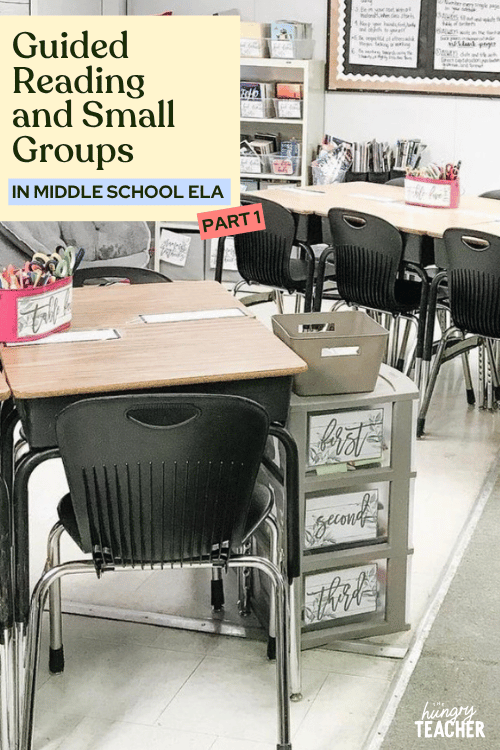
Organizing Guided Reading Supplies
Organization can make or break your small group system.
I struggled at first—binders, drawers, color-coded bins—it was chaos. Eventually, I found what worked:
🎨 Color-Coded Bins.
Each group had its own color. Students were responsible for grabbing their bin when it was time for small groups, which cut down on transition time and confusion.
🪣 Group Supply Bin:
Pencils, pens, and highlighters
Sticky notes and evidence-based terms charts
Reading and writing reference tools
Interactive notebook pages and close reading toolkits
Everything lived within arm’s reach of my table, so we could start immediately.
I went to Walmart and bought these bins (you can get them here on Amazon), then color-coded them. Now, when I meet with a group, they just grab their bin, or a student can get their supplies out of their group’s bin.
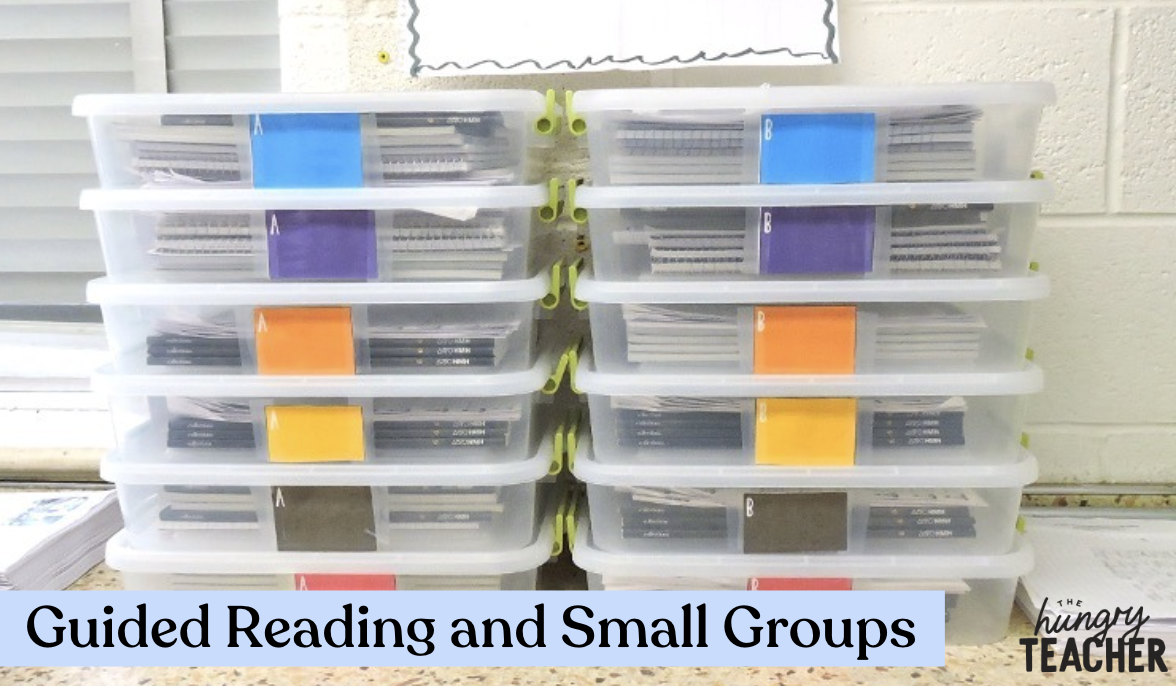
What We Did During Small Group Time
The biggest question teachers ask:
“What do you actually do in middle school guided reading groups?”
This was probably my number one question as an elementary teacher who went to middle school. With younger grades, you can typically read short books in one session, or maybe in a couple of sessions. The focus is on teaching students reading skills.
I still needed to teach this to some of my intensive groups, but in general, I needed to push my middle schoolers to think critically about their reading.
Nonetheless, it’s not much time to do it all, so in my current 55-minute classes, I see groups once a week. I want the lessons to be focused, rigorous, and effective. Also, I don’t want the lessons dragged out for weeks on end.
Here’s what worked best for me:
1. Nonfiction Articles
Short, high-interest articles (like those from NewsELA or ReadWorks) were perfect for skill-based discussion and annotation.
2. Close Reading Passages
I loved using passages from Commonlit.org, Kristine Nannini’s Teaching and Tapas, Keith Geswein, and my own close-reading passages. My close reading passages are currently an exclusive resources for Hub members, but you can learn more here.

3. Skill-Based Task Cards or Exit Slips
Quick, targeted practice for inferences, context clues, grammar, or writing skills. Try my Middle School ELA Exit Ticket Bundle, which includes exit tickets for literature, nonfiction, and grammar. Or you can grab 30 free exit tickets RIGHT HERE.
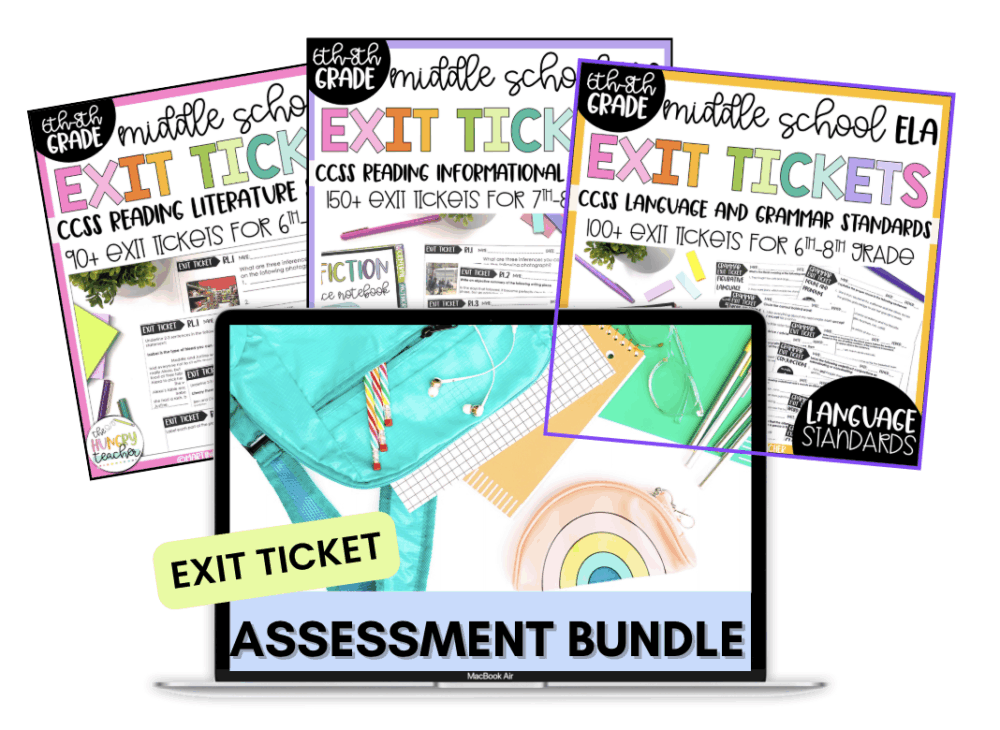
4. Reading Responses + Quick Writes
Students read short stories or paired texts and wrote focused responses.
I used my Editable Literature Rubrics and Reading Response Rubrics for consistency.
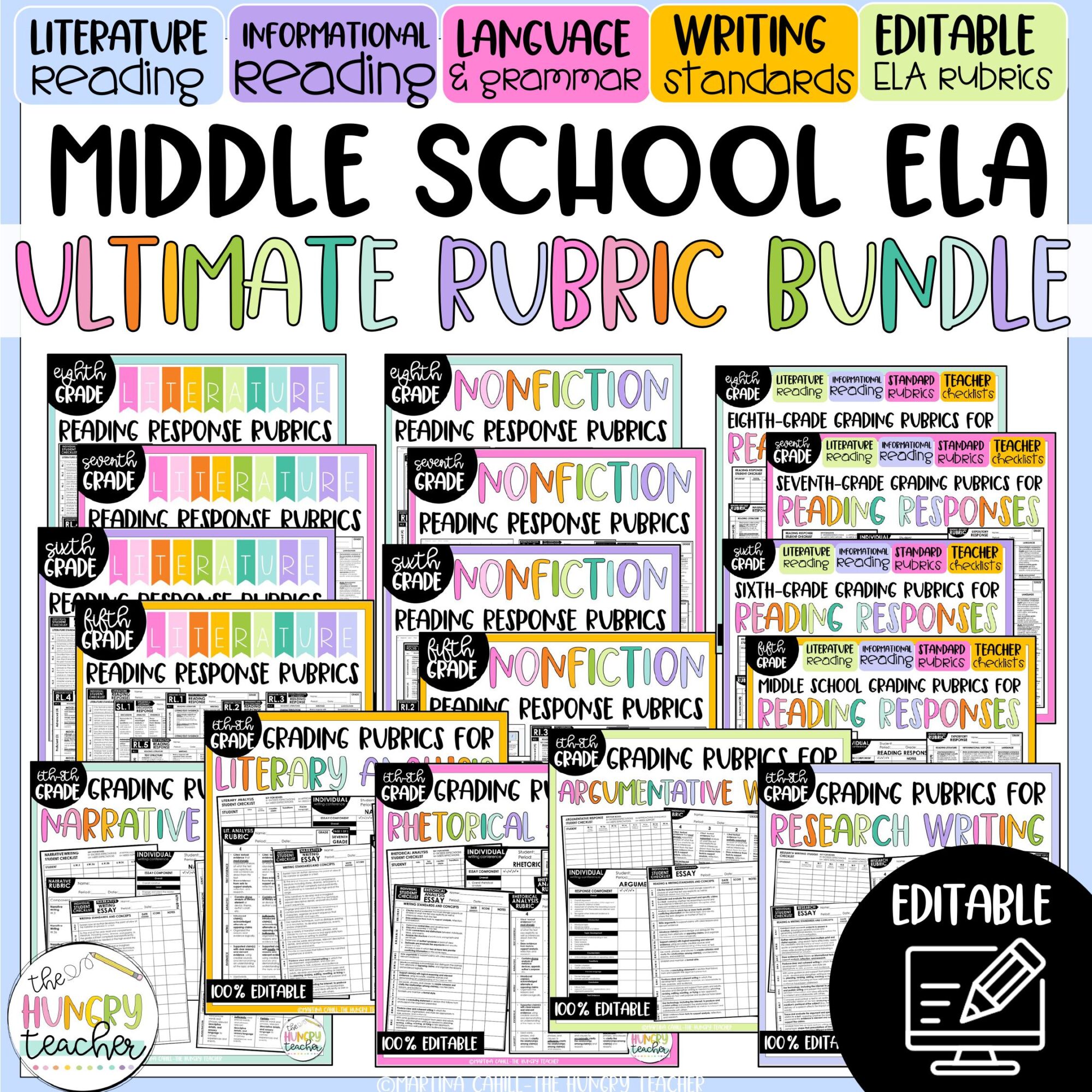
5. Test Prep (In Moderation)
We worked on test prep in small doses, focusing on analysis and reasoning—not just bubbling in answers.
OTHER SMALL GROUP MATERIALS
This isn’t super pretty, but this counter was right next to my small group table. The bins were right next to my table. These bins kept our close reader booklets (they came with my curriculum or I sometimes made booklets through our print shop).
Next to this, you see stacks of papers. These are new close-reading passages I made for groups that week. As I would meet with groups, students would get a new one, write their name on top, and then it would go in their group’s bin until we finished it. The shelf below held my reading assessment kit and task cards in the black bins.
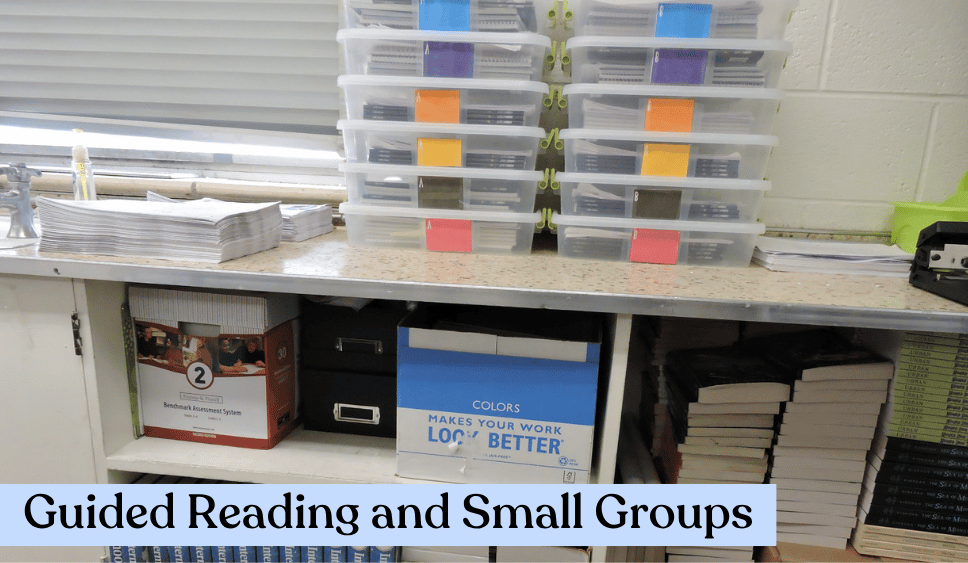
GUIDED READING ROUTINES
In small groups, I found that I consistently used specific resources and tools across all of them. I kept many of these resources within arm’s reach or within easy reach for the students and me.
These “Evidence-Based Terms” and their corresponding chart paper were used almost every single day with nearly every single group. We were always citing evidence, and it made more sense for these to be right behind us for the small group. The posters are free in Leslie Ann’s TPT store, and I think I got the chart idea from The Creative Apple on her blog.
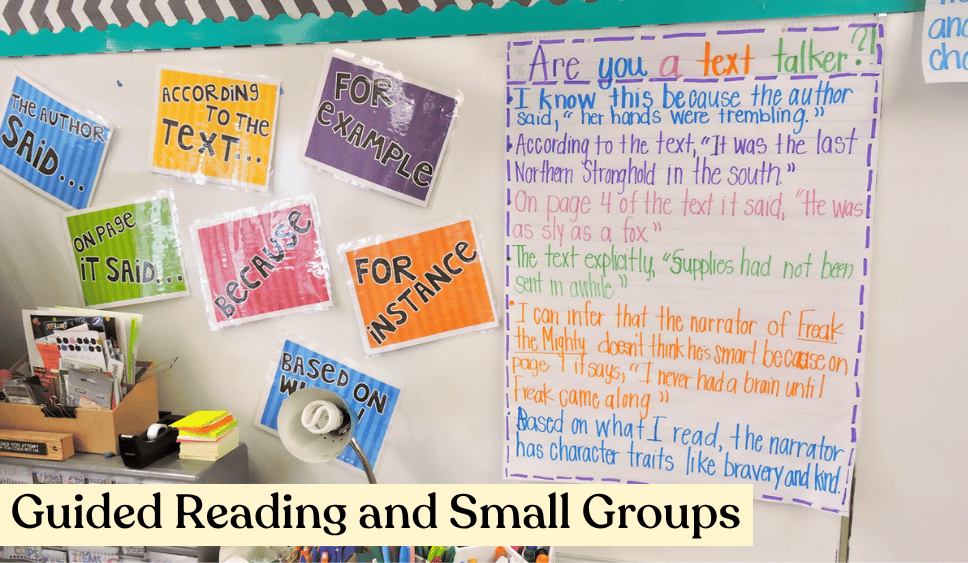
This was the bin that was always within arm’s reach of me at my group table. It held writing utensils, my reading intervention strategies reference books, notebook paper, interactive notebook supplies, and our close reading tool kits. It only had stuff for small groups, so I never wasted time waiting for students to get what they needed for their tables/desks. I had everything we needed.

CLOSE READING TOOLKITS
The close reading toolkits contained a variety of things from both The Creative Apple and Leslie Ann. Essentially, this was our go-to supply. When kids came to the table, they got a toolkit.
It usually contained 3 highlighters (for close reading), an evidence-based terms bookmark, a close reading note guide, an *R.A.C.E. bookmark, and a pen or a pencil.
*R.A.C.E – Restate the Question, Answer the Question, Cite Evidence, Explain the Evidence.

Using R.A.C.E. in Small Groups
If you’ve ever used the R.A.C.E. (Restate, Answer, Cite, Explain) or R.A.C.E.S. strategy, you know how powerful it is for helping students organize written responses.
I used it daily in small groups. Students even kept R.A.C.E. bookmarks in their toolkit to reference while writing and discussing. You can grab my R.A.C.E. Strategy Resource here.
Over the years, I used the R.A.C.E. and R.A.C.E.S. strategy more and more in my classes.
My color schemes changed, so I made posters and bookmarks to accompany them.
You can click here to get my R.A.C.E. strategy resource for your classroom.

Why Guided Reading Works in Middle School
Middle schoolers still need explicit reading support—but they also crave independence.
Guided reading bridges that gap.
✅ It personalizes instruction.
You can meet students exactly where they are—without embarrassing them in front of the class.
✅ It builds relationships.
Small groups create space for real conversation and connection.
✅ It reinforces essential skills.
You can reteach, enrich, and extend literacy skills in ways that whole-group lessons can’t.
✅ It fits into your limited time.
With intentional planning, guided reading can fit perfectly into your 45–60 minute periods.
Next in the Series:


Get free middle school guided reading forms sent
to your inbox.
Subscribe to The Hungry Teacher and get the middle school ELA small groups toolkit sent straight to your inbox. You’ll also get access to all of my exclusive freebies and teaching ideas.
Want a sneak peek at teaching The Hungry Teacher way—with support, structure, and strategy?
When you join the waitlist for The Hungry Teacher’s Hub membership, you get three free classroom-ready resources: a theme unit, an expository writing unit, and a grammar unit introducing mentor sentences. Plus, you’ll get immediate access to a selection of exclusives from the Hub, including editable sub plans, pacing guides, and more.
No strings attached. Just resources you can use right now—and a heads-up when the Hub opens.
3 Free Middle School ELA Units—yours to keep!
JOIN THE WAITLIST + A FREE GIFT
Where to next, line leader?
Welcome to The Hungry Teacher! We create resources that are easy to use, practical, and get results. Teach with confidence—and make it home before dinner.
xo, the hungry teacher
Great post! You are super organized and I love how you've planned your workshop!!
Melissa
Wild About Fifth
Thank you so much! I wish I could say the rest of my life was organized ha!
Thanks again!
Martina
Gosh I love all of this so much!! I've come back and read this several times to get myself motivated!!
Muah! Thanks! All my motivation is gone after this haha! It took all my energy to do this series ;).
This text is worth everyone’s attention. How can I find out more? Really great news!!! this information is well worth looking everyone. Good tips.
____________________
Lesson plans
I like this post.And I guess that they having fun to read this post.they shall take a good site to make a information.thanks for sharing it to me.
Friends of education